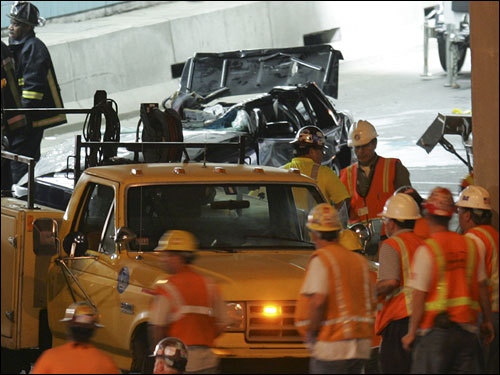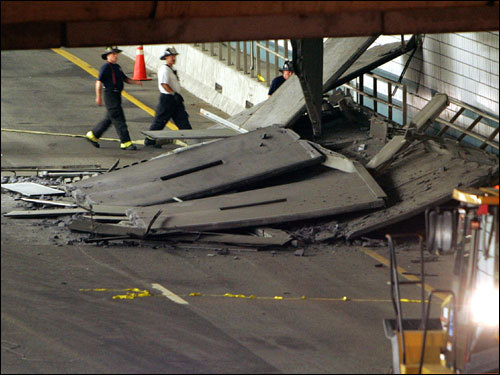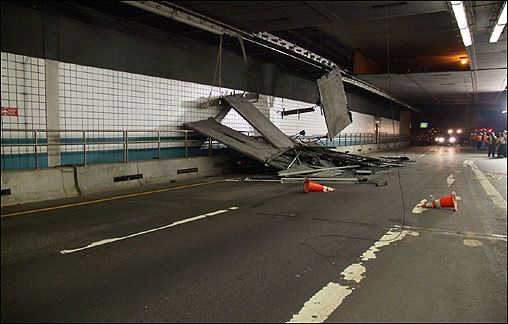About 11:00 p.m. on Monday, July10, 2006, a couple were traveling eastbound in the Interstate 90 connector tunnel in Boston, Massachusetts on their way to Logan airport. As they approached the end of the connector tunnel, a section of the tunnel’s suspended concrete ceiling became detached from the tunnel roof and fell onto the vehicle. Concrete panels from the ceiling crushed the right side of the vehicle roof as the car came to rest against the north wall of the tunnel. A total of about 26 tons of concrete and panel suspension hardware fell onto the vehicle and the roadway. The driver’s wife was fatally injured, and the driver was able to escape with minor injuries.
The NTSB determined that the cause of the ceiling collapse in the D Street portal of the connector tunnel was the use of an epoxy anchor adhesive with poor creep resistance which meant that the epoxy formulation was not capable of sustaining long-term loads. Over time, the epoxy deformed and fractured until several ceiling support anchors pulled free causing a portion of the ceiling to collapse. Use of an inappropriate epoxy formulation resulted from the failure of Gannett Fleming, Inc., and Bechtel/Parsons Brinckerhoff to identify potential creep in the anchor adhesive as a critical long-term failure mode. In addition, Powers Fasteners, Inc., failed to provide the Central Artery/Tunnel project with sufficiently complete, information about the suitability of the company’s Fast Set epoxy for sustaining long-term tensile loads. Contributing to the accident was the failure of Powers Fasteners, Inc. to determine that the anchor displacement that was found in the high-occupancy vehicle tunnel in 1999 was a result of anchor creep due to the use of the company’s Power-Fast Fast Set epoxy, which was known by the company to have poor long-term load characteristics. Also contributing to the accident was the failure of Modern Continental construction Co. and Bechtel/Parsons Brinkerhoff, subsequent to the 1999 anchor displacement, to continue to monitor anchor performance in light of the uncertainty as to the cause of the failures. The Massachusetts Turnpike Authority also contributed to the accident by failing to implement a timely tunnel inspection program that would likely have revealed the ongoing anchor creep in time to correct the deficiencies before an accident occurred.
The specifications for the Ted Williams Tunnel did not require that the tunnel incorporate a provision for attaching a suspended ceiling, even thought the owners knew that one would be needed to accommodate the tunnel ventilation system. The D Street portal, which was completed before the Ted Williams Tunnel, was expected to use the same post-installed ceiling as the Ted Williams Tunnel; thus, it also had no embedded ceiling supports.
The lack of embedded anchoring devices led the section design consultant for the Ted Williams Tunnel finishes to devise a ceiling system that relied on adhesive anchors for support. About 24,000 adhesive anchors were installed the Ted Williams Tunnel, but various installation problems encountered during this process prompted CA/T project authorities to direct that the balance of the I-90 connector tunnel (except for the D Street portal, which was already built) be constructed with embedded steel channels in the roof so that adhesive anchors would not be needed.
Also, during construction of the Ted Williams Tunnel, it was decided to adopt a simpler and cheaper ceiling system for future tunnels. Instead of the custom-engineered laminated lightweight concrete panels that had proved so costly and time-consuming to install in the Ted Williams Tunnel, they would use cheaper (and more easily installed) precast concrete panels for the I-93 tunnel and the I-90 Connector tunnel.
The ceiling system that was adopted consisted of a group of concrete panels supported by a steel framework suspended from rods attached to roof hanger plates. In the I-93 tunnel, these plates would be attached to the roof girders using welded studs. In the I-90 tunnel, they would be attached to the steel channels in the roof. Because the D Street portal roof had neither girders nor embedded channels, section design consultant Gannett Fleming specified the use of adhesive anchors. The anchors that were installed in the D Street portal in response to that specification were the ones that failed on July 10, 2006.













